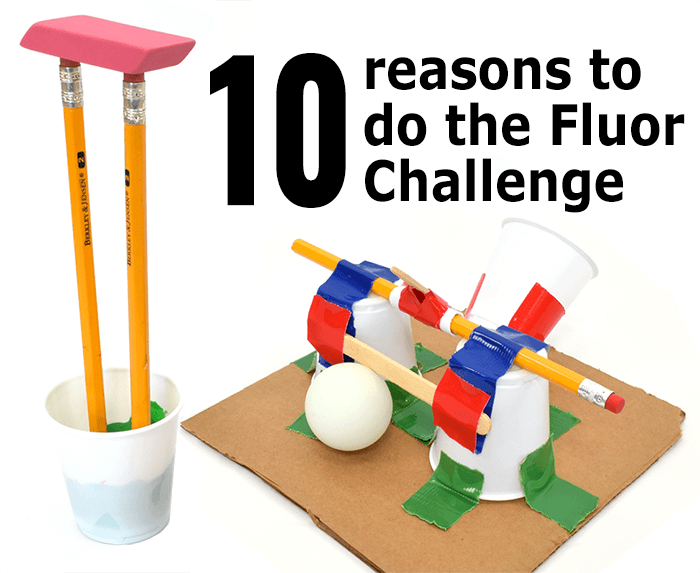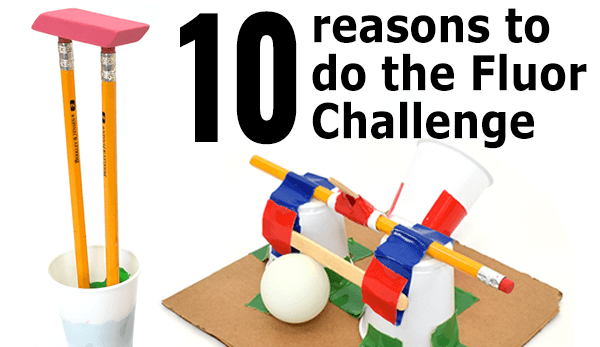10 Reasons to Do the Fluor Challenge in Addition to $10,000 in Prizes!
The 2020 Fluor Challenge is on, and $10,000 is up for grabs! If you are waffling about whether or not to do this year's STEM challenge, we have 10 reasons to help convince you.

The annual Fluor Engineering Challenge makes it fun for students to try engineering. The 2020 Fluor Challenge is the Cricket Wicket Knockdown Challenge.
This year's Fluor Challenge involves building a device (which might be something like a catapult or slingshot launcher) that can launch a ping pong ball and knock an eraser off a pretend "wicket." The goal is to knock the eraser off as many times as possible in the allotted time. The final score is based on how many times the eraser was knocked down and what materials were used to build the device.
A Chance to Win Part of $10,000 for Your School or Organization
There are ten $1,000 (USD) prizes up for grabs in the Fluor Challenge. All complete entries (see the rules for geographic locations) are entered in random drawings for a chance to win money for the school or qualified organization. That's a chance to win $1,000 for your program simply by having students try engineering and then uploading their entries — regardless of score.
With $10,000 in prize money to be awarded in the random drawings, we hope you will have all of your students take this year's Cricket Wicket Knockdown Challenge.
You still aren't sure if you should make time for the Fluor Challenge with students?
10 Reasons to Do the Fluor Challenge with Students
- It's fun. The Cricket Wicket Knockdown challenge is engaging. Teachers who enter the challenge each year tell us how much their students enjoyed both the design and testing portions of the challenge.
- It's accessible. The challenge is open to students in grades K-12 — and the emphasis of the challenge is on trying the challenge rather than on getting the best score. (Tip! Sample devices shown in the directions and overview video are helpful starting points for brainstorming solutions with younger students.)
- Creative thinking. Students may surprise you with their design ideas for their launch devices. There are an infinite number of approaches they can take!
- Problem solving. Students may find their designs don't work the first time. They will need to practice problem solving to identify problems and find ways to improve their designs. Seeing their perseverance and determination in action can be incredible!
- Engineering design. Engineering is a critical component of STEM learning. Doing the Fluor Challenge emphasizes brainstorming, prototyping, testing, and iteration, all important steps of the engineering design process.
- Teamwork. While solo teams are allowed, the Fluor Challenge is perfect for teams and small groups (up to 4). Students practice collaboration and communication skills as they work together to build, test, and improve their final designs.
- Simple materials. The challenge uses basic materials (like pencils and duct tape) that are easy to find, and students can choose which of the allowable materials they will use in building their devices.
- Science concepts in action. Engineering projects often combine engineering design and other areas of science. Students doing this year's challenge will be learning about and putting core concepts related to forces and kinetic energy into practice.
- It's free to enter! There are no fees associated with the Fluor Challenge. Entries are accepted until March 13, 2020.
Fluor Challenge Resources
Use the resources below to do this year's Fluor Challenge with students:
- Cricket Wicket Knockdown: 2020 Engineering Challenge: overview video
- Cricket Wicket Knockdown Challenge: instructions for students of all ages working independently on the project (alone or in teams)
- Elementary School Cricket Wicket Knockdown Lesson Plan
- Middle School Cricket Wicket Knockdown Lesson Plan
- High School Cricket Wicket Knockdown Lesson Plan
- Fluor Engineering Challenge Rules
Entries for the 2020 Fluor Challenge will be accepted through March 13, 20120.
Categories:
You Might Also Enjoy These Related Posts:
- Plastics and Earth Day - Science Projects
- Arduino Science Projects and Physical Computing
- 10+ Robotics Projects with the BlueBot Kit
- 5 STEM Activities with Marshmallow Peeps
- March Madness Basketball Science Projects: Sports Science Experiments
- Women in STEM! More than 60 Scientists and Engineers for Women's History Month
- Explore Artificial Intelligence and Machine Learning with Student AI Projects
- 10 Reasons to Do the Rubber Band Car Engineering Challenge










